Each human being is a cosmos, animated by numerous perceptual, cognitive, behavioral and emotional processes, their present and their history. In a single brain, those processes are coordinated by a phenomenon called self-organization [learn more]. When humans interact, those many individual processes come into contact and new order emerges. The challenge of social coordination dynamics is to understand the neurobehavioral mechanisms unfolding over the course of social interactions. It is a research program that cuts across levels of description: neural, behavioral & social. 'Social Coordination Dynamics' is a principle research axis at the Human Brain and Behavior Laboratory and it is led in collaboration with J. A. Scott Kelso and Gonzalo C. de Guzman.
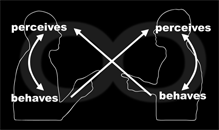
Information flows, behavioral self-organization
When elements of a system come to interact, their activity ceases to be solely determined by their selves: their behavior also depends on the system's other elements and their dynamics. In social systems of interacting humans, this coupling is realized by information flows: a person's behavior enter another person's brain through perceptual channels. From there, the perceiver's future actions unavoidably depend on the interplay of intrinsic dispositions and extraneous information. When people perform simple repetitive finger movements in front of each other for instance, they exhibit spontaneous tendencies for synchronized behavior; and their collective behavior obey similar laws as those observed in individual coordination (e.g. bimanual or sensormimotor). This phenomenology allows for social behavior to be modeled by mathematical equations, and for surrogate social partners to be designed [see below].
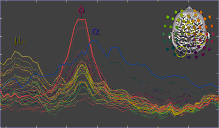
Social neuromarkers, neuromarker dynamics
Neural circuits originate spatiotemporal signatures in the EEG called neuromarkers. These neuromarkers are transiently recruited to serve specific functions of the human brain, for instance spatial and selective attention, somatosensation or motor coordination. A number of neuromarkers participate in social behavior, including alpha, phi complex, mu rhythms and newly identified nu and kappa. Our studies aim at discovering those neuromarkers, deciphering their functional role, the timing of their engagement and disengagement, and how they interplay with each other.
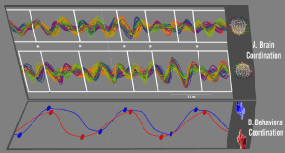
Coupled brains
When tracking the spatiotemporal dynamics of a system’s component, signs of its interdependency to other components can be recognized. For instance, if a component behaves with a simple oscillatory dynamics (such as Huygens’ sympathetic clock pendulum), then its coupling to other components can be deduced from phase-locking or metastability with other components’ behavior. The brain of interacting people is coupled through information flows. Can we identify mechanism(s) through which neural interdependencies are expressed? There may be a number of such mechanisms intervening during social interactions. Our studies revealed a complex phenomenon of social coupling: under some circumstances when people interact, the collection of spatiotemporal patterns that animate their brains may well be different (their brain networks don’t do the same thing at the same time), but they tend to follow a common tempo (they change their transient brain patterns at the same time). We propose that this mechanism enhances social systems’ complexity.
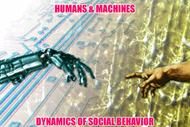
Interactions between humans and machines
Collective behavior of interacting people can be modeled by dynamical laws. This allows us to substitute one or several human participant(s) with surrogate artificial agent(s): the virtual partners. Virtual partners’ dispositions can be altered parametrically: a great opportunity to map the social system’s parameter space comprehensively. One outcome of this research thrust was to identify novel coordination behaviors – phenomena that had not been known despites several decades spent studying Coordination Dynamics in models and experiments. Another outcome is to comprehend which manipulations enhance coordination, or shift the weight of influence that each partner exerts on others. This knowledge may be harnessed in human societies: helping in the design of strategies to modulate coordination between people. It may also be useful to improve performance of tasks that are to be performed jointly by humans and machines.
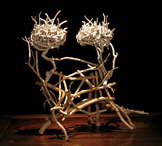
Significance and broader impact
The goal of our group is to understand the fundamental mechanisms of human interactions at multiple levels: neural, behavioral and social. Our research has implications in a number of fields.
- A broad number of diseases that afflict our societies comes with alterations of social behavior: including depression, autism, schizophrenia, Alzheimer’s disease, epilepsy, Parkinson’s disease and brain lesions to name a few. Our research lays the foundation for clinical research and improved management of those diseases.
- It is the very nature of human societies that children are raised through their interactions with adults and peers. Besides, this social pattern persists through a lifetime of learning experiences. Discoveries on how to modulate the strength of social interactions preludes better human development and enhanced educational practices.
- Our world is increasingly dependent on machines, and on how well human and machine interact in the performance of tasks and activities. Our theories and findings anticipate the design of better human-machine interactions.
In the media
ScienceDaily: New Brain Neuromarker May Shed Light On Autism And Schizophrenia
Scientific American Mind: Social Rhythms
Physorg: Scientists create hybrid system of human-machine interaction
Learn more: publications and public communications
- Suutari, B., Weisberg, S., Tognoli, E., Kelso, J.A.S. (in prep). Neuromarkers dynamics during individual and social behaviors. [abstract]
- Suutari B.S., Weisberg, S.A., Tognoli, E., Kelso, J.A.S. (2010). A fresh look on mu rhythms: individual and social behaviors. Society for Neurosciences Itinerary Planner program 199.12, San Diego, California, November 13th-17th. [direct link] [abstract] [PPT]
- Tognoli, E., Kelso, J.A.S. (submitted). The coordination dynamics of social neuromarkers. Frontiers in Human Neuroscience. [abstract]
- Tognoli, E., Kelso, J.A.S. (2011). Neuromarkers of synchronic and diachronic social behaviors. Society for Neuroscience Itinerary Planner program 832.25, Washington DC, November 12th-16th. [direct link] [abstract] [PPT]
- Tognoli, E., Kovacs, A.J., Suutari, B., Afergan, D., Coyne, J., Gibson, G., Stripling, R., Kelso, J.A.S. (2011). Behavioral and brain dynamics of team coordination, Part I: task design. In Hutchison, D.; Kanade, T.; Kittler, J.; Kleinberg, J. M.; Mattern, F.; Mitchell, J. C.; Naor, M.; Nierstrasz, O.; Pandu Rangan, C.; Steffen, B.; Sudan, M.; Terzopoulos, D.; Tygar, D.; Vardi, M. Y.; Weikum, G.; Schmorrow, D. D. & Fidopiastis, C. M. (Eds.). Foundations of Augmented Cognition. Directing the Future of Adaptive Systems, Springer Berlin Heidelberg, 6780: 257-264. [direct link] [abstract] [PDF] [companion PPT].
- Tognoli, E., Kovacs, A.J., Suutari, B., Afergan, D., Coyne, J., Gibson, G., Stripling, R., Kelso, J.A.S. (2011). Behavioral and brain dynamics of team coordination, Part II: neurobehavioral performance. In Hutchison, D.; Kanade, T.; Kittler, J.; Kleinberg, J. M.; Mattern, F.; Mitchell, J. C.; Naor, M.; Nierstrasz, O.; Pandu Rangan, C.; Steffen, B.; Sudan, M.; Terzopoulos, D.; Tygar, D.; Vardi, M. Y.; Weikum, G.; Schmorrow, D. D. & Fidopiastis, C. M. (Eds.). Foundations of Augmented Cognition. Directing the Future of Adaptive Systems, Springer Berlin Heidelberg, 6780: 376-382. [direct link] [abstract] [PDF].
- Tognoli, E., De Guzman, G.C., Kelso, J.A.S. (2011). Interacting Humans and the Dynamics of their Social Brains. In J. S. Wang, R. & Gu, F. (Eds.) Advances in Cognitive Neurodynamics (II), Springer Netherlands, 139-143. [link] [direct link] [abstract] [PDF] [companion PPT]
- Kelso, J.A.S., de Guzman G.C., Reveley C., Tognoli, E. (2009). Virtual Partner Interaction (VPI): Exploring Novel Behaviors via Coordination Dynamics. PLoS ONE 4(6) e5749. [direct link] [abstract] [PDF]
- Kelso, J.A.S, de Guzman, G.C., Reveley, C., Tognoli, E. (2008). From Dynamic Clamp to Virtual Partner Interaction (VPI): Exploring human brain-behavior relations via Coordination Dynamics. Society for Neuroscience Itinerary Planner Program 798.24, Washington DC, USA, November 15th-19th. [direct link] [abstract] [PPT]
- de Guzman, G.C, Tognoli, E., Kelso, J.A.S. (2009). Learning with an avatar: Skill acquisition using Virtual Partner Interaction. IECRI, Madrid, Spain, November 16th-19th.
- Tognoli, E., (2008). EEG coordination dynamics: neuromarkers of social coordination. In Fuchs A, Jirsa VK (eds.) Coordination: Neural, Behavioral and Social Dynamics, Springer Berlin Heidelberg, 309-323. [link] [direct link] [abstract] [PDF]
- Tognoli, E., (2007). EEG coordination dynamics: neuromarkers of social behavior. Coordination Dynamics: An international conference held in honor of J.A.Scott Kelso's 60th birthday. February 22nd-25th. [link] [abstract] [PPT]
- Tognoli, E., Lagarde, J., De Guzman, G.C., Kelso, J.A.S. (2007). From the cover: The phi-complex as a neuromarker of human social coordination. Proceedings of the National Academy of Sciences, 104, 8190-8195. [direct link] [from the cover] [abstract] [PDF]
- Tognoli, E., de Guzman, G.C. Lagarde, J. Kelso J.A.S. (2006). The phi complex: a neural signature for effective social coordination and its breakdown. Society for Neuroscience Itinerary Planner Program 549.28, Atlanta, USA, October 14th-18th. [abstract] [PPS]
- Tognoli, E., de Guzman, G. C., Kelso, J. A. S. (2006). Twin-peaks (the lateralized x-rhythms): a dual-EEG study of effective social coordination. Gerontological Society of America Annual Meeting, Dallas, USA, November 16th-20th. [abstract] [PPT]
- Tognoli, E., (2010). Of Neurons and Humans: Collective Behaviors. University of Cincinnati, May 7. [PPT]
- Tognoli, E. (2010). A world of coordination: from neurons to humans. CCSBS seminar. [PPT]
- Kelso, J.A.S., Tognoli, E., Benites, D., de Guzman, G.C. (2009). Exploring the innards of human social coordination via Brain Coordination Dynamics. Society for Neuroscience Itinerary Planner Program 577.15, Chicago, USA, October 17th- 21st. [direct link] [abstract] [PDF]
- Tognoli, E., Benites, D., de Guzman, G.C., Kelso, J.A.S. (2009). Neural mechanisms of social coordination: Continuous EEG analysis using a novel 4d colorimetric method. Joint Action Meeting, Amsterdam, The Netherlands, July 27th-29th. [abstract] [PPT]
- Benites, D., Tognoli, E., de Guzman, G.C., Kelso, J.A.S. (2009). The complementary nature of joint~individual action: neural correlates uncoordinated action and self-behavior. Joint Action Meeting, Amsterdam, The Netherlands, July 27th-29th. [abstract] [TIF]
- Tognoli, E., Kelso, J.A.S. (2008). Neuromarkers of social behavior: paving the way to electrophysiological endophenotypes of autism. Autism Society of America, Orlando, USA, July 12th-14th. [abstract] [PPT]
- Tognoli, E., Magne, C., de Guzman, G. C., Tuller, B., Kelso, J. A. S. (2007). Brain rhythms underlying intentional social coordination. Society for Neuroscience Itinerary Planner Program 304.24, San Diego, USA, November 3rd-7th. [direct link] [abstract] [PPT]
|

